
|

|
The Acceptance of Christianity in Viking-Age Iceland
The story of the conversion to Christianity in Iceland is so remarkable that it is worth telling in some detail, since it illustrates many aspects of culture, society, and law in Viking-age Iceland. Elsewhere, Christianity was accepted as a matter of faith, or imposed by force. In Iceland, acceptance of the new religion was a matter of law, a carefully crafted compromise that was characteristic of Viking-age Iceland.
In the 10th century, Icelanders by and large worshiped the old pagans gods of their ancestors. Some settlers had adopted Christianity before traveling to Iceland, but the literary sources say that within a generation, their children forgot the new religion and reverted to the old. Only in a few tiny pockets was the new religion observed, such is in Kirkjubęr in the south.
In the middle of the 10th century, King Hįkon Haraldsson of Norway introduced Christianity to his land, but the new religion was not widely adopted.
|
When King Ólafur Tryggvason seized the throne in the year 995, he forcefully reintroduced the new religion, dealing harshly with those who opposed his efforts. While it is possible the king had a personal conviction in the new religion, he must also have seen the political advantages to uniting the country under one faith and exploiting the administrative capabilities of the church. |
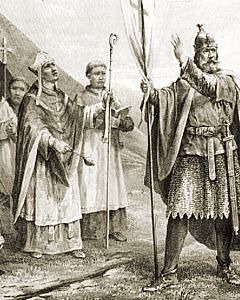 |
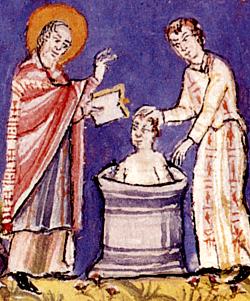 |
Ólafur also set his sights on other lands inhabited by Norwegians, including Iceland. He pressured the Icelandic gošar (chieftains) to adopt the new religion and sent missionaries to Iceland. One of these missionaries, Žangbrandur, preached the faith and baptized several leading gošar, but most people opposed his work and mocked him. In return, he killed several men who composed scurrilous verses about him. |
When Žangbrandur returned to Norway, he briefed the king, who was infuriated by the Icelanders refusal to accept the new religion. The king said he would mutilate or kill all the Icelanders in Norway in retaliation.
At the Alžing meeting in Iceland earlier that year, Hjalti Skeggjason, a Christian, was sentenced to lesser outlawry for composing and reciting verses that mocked the goddess Freyja. He and his father in law, Gizurr, traveled to Norway to stay there for the duration of the sentence. They went to the king and made an agreement. In exchange for the king's release of the Icelandic hostages, the two men agreed to return to Iceland to promote the new faith.
|
The next year, the year 1000, Gizurr and Hjalti returned to Iceland and traveled to the Alžing, gathering armed supporters along the way. Christians and heathens alike prepared for a battle at the Alžing. |
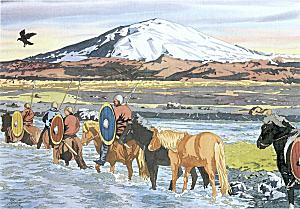 |
When the Alžing convened, the Christians asked Sķšu-Hallur Žorsteinsson to proclaim their law, in essence becoming their lawspeaker. Two separate Icelandic states were forming, one based on Christian laws and the other on traditional pagan laws. Prominent men realized this could not be permitted to happen, because it would tear apart the country. Sķšu-Hallur made an agreement with the legally-appointed lawspeaker, the pagan goši Žorgeir Ljósvetningagoši, that Žorgeir should proclaim the law.
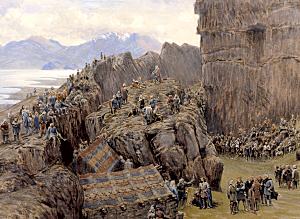 |
Žorgeir returned to his booth to seek a solution that would satisfy both pagans and Christians. Ķslendingabók tells the story:
Žorgeir announced his plan. Henceforth, all Icelanders should be baptized and be Christian. Heathen sacrifice and worship could continue secretly, if desired, but would be penalized if witnesses came forward. Some heathen practices could continue in public. |
It was a clever compromise. It meant that outdoors, everyone had to practice the Christian faith, but indoors, where there were no witnesses, people could practice whatever faith they preferred. It seems likely that neither side was satisfied, but both sides agreed to the compromise. The desire to maintain the law outweighed other considerations.
|
A story recorded much later says that Žorgeir Ljósvetningagoši returned home to his farm at Ljósvatn and took the idols from his temple and threw them in to the nearby waterfalls, which took on the name Gošafoss (falls of the gods). The story appears to date from the 19th century, but the name of the falls is much older, suggesting that the story is a recent fabrication. |
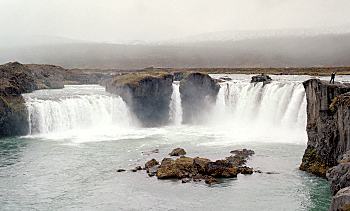 |
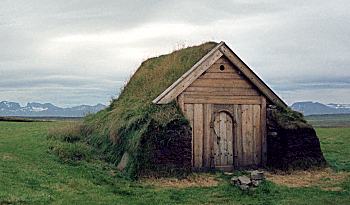 |
Realistically, there were few changes. The gošar retained their power. Rather than being intermediaries to the old heathen religion, they became the intermediaries to the new church. Gošar and prominent farmers tore down their temples and built churches (left), becoming patrons of the new church. A number of heathen practices, such as exposure, and the eating of horse meat continued. |
When Ólafur Haraldsson came to the throne of Norway in 1015, he turned his attention to the Christian faith in Iceland. He convinced the Icelanders to end all their heathen practices, and he sent priests and a bishop. Prominent families sent their sons overseas to become priests and, ultimately, bishops of the church. By the middle of the 11th century, a church hierarchy was in place, with an Icelandic bishop at its head. Thus, control of the church remained in the hands of the chieftains and other leading men.
A video presentation on The Coexistence of Heathenry and Christianity in the Viking Age by Dr. William R. Short, manager of Hurstwic, LLC. The lecture was part of the Hurstwic Heathen study group series of presentations and discussions. |
|
|
©2014-2025 William R. Short |